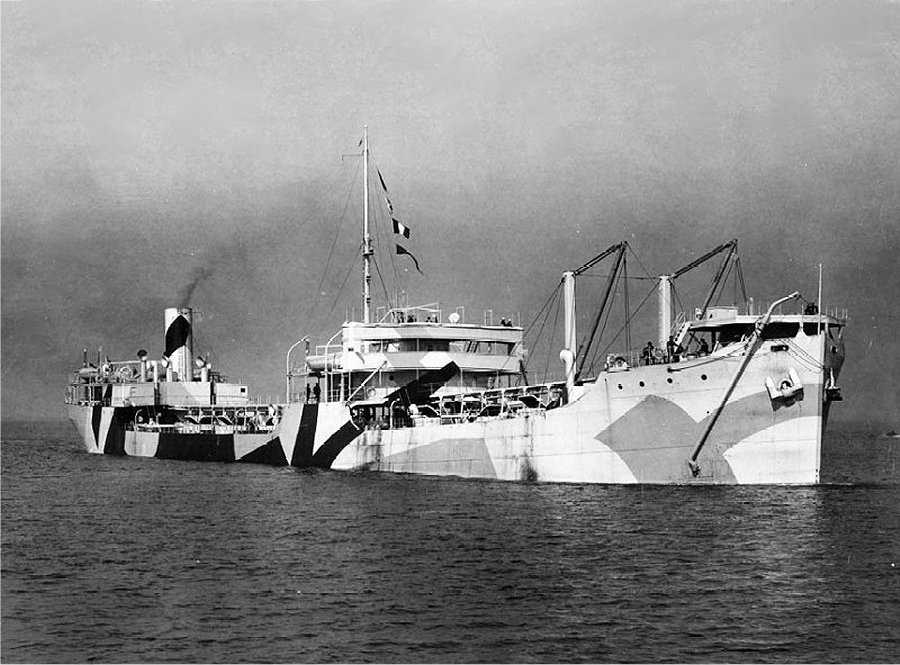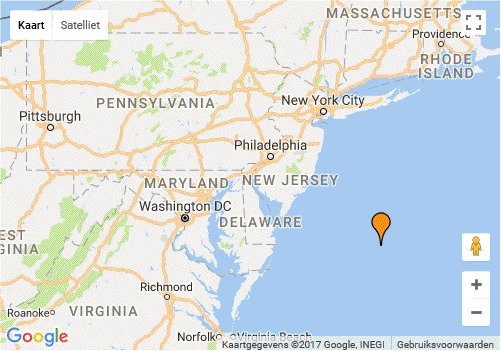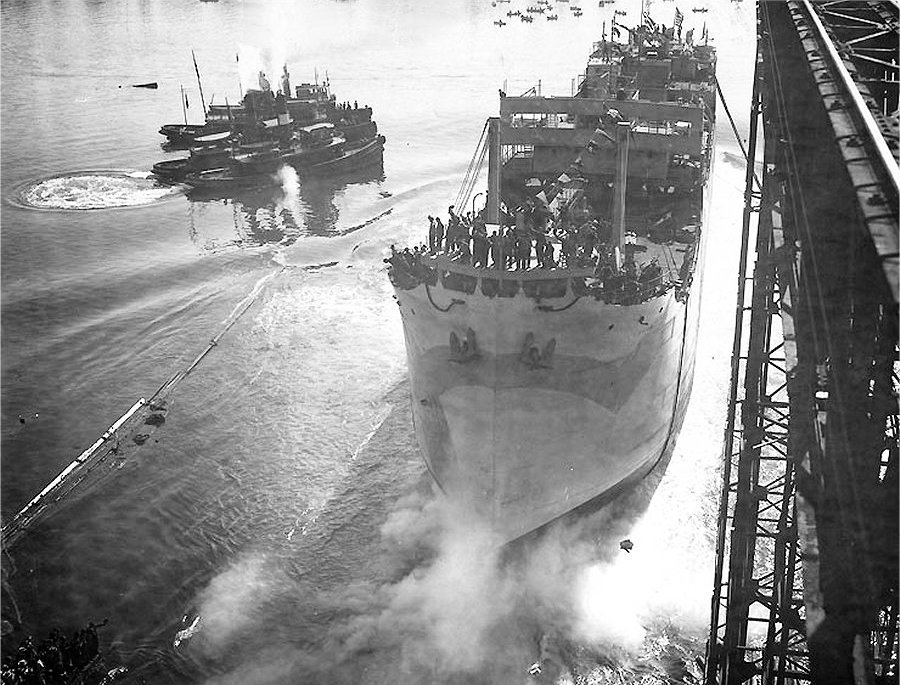Auke Visser's Other Esso Related Tankers Site | home
W. L. Steed - ( 1933-1935)
See also : W. L. Steed - ( 1920-1933) & W. L. Steed - (1933-1942)
SS W.L. Steed (American Tanker, 1918)
Launching, at the Fore River Shipbuilding Company shipyard, Quincy, Massachusetts, 1918.
Note her pattern camouflage, and tugs standing by in the background.
SS W.L. Steed, photographed in 1918, while painted in pattern camouflage.
This ship was USS W.L. Steed between September 1918 and March 1919. On 2 February 1942, while in commercial service,
she was torpedoed and sunk by the German submarine U-103.

Tanker: Built in 1918 by the Fore River Shipbuilding Co., Quincy, MA; Acquired by the Navy 10 August 1918 at Boston;
Commissioned W. L. Steed (ID 3449) 18 September 1918; Decommissioned 26 March 1919, returned to the United States
Shipping Board and struck from the Naval list the same day; Sold in 1922 to the Pan-American Petroleum and Transport
Co.; Sold in 1937 to the Standard Oil Co. of New Jersey; Sunk 2 February 1942 by U-103. Fate unknown.
Specifications: Displacement 13,000 t.; Length 431' 10"; Beam 56'; Draft 25' 6"; Speed 10.5 kts.; Complement 96;
Armament one 3".
S.S. W.L. Steed, a 6450 gross ton (13,000-tons displacement) oil tanker, was built at Quincy, Massachusetts, as part of the World War I shipbuilding effort. Transferred to the Navy upon completion, in September 1918 she was placed in commission as USS W.L. Steed (ID # 3449) and assigned to the Naval Overseas Transportation Service. Problems with her steering gear aborted her first attempt to carry oil across the Atlantic to England, and she was still in American waters when the 11 November Armistice brought the war's combat phase to an end. Following repairs, W.L. Steed completed one voyage to France and had a second prematurely ended by damage. She was decommissioned in late March 1919 and returned to the U.S. Shipping Board.
In 1920 W.L. Steed entered commercial service with the Pan-American Petroleum and Transportation Company.
In 1933 she went to the Pan-American Foreign Corp.
The Standard Oil Company became her owner in 1937 and operated her for the rest of her career. On 2 February 1942, while off the U.S. East Coast with a cargo of Columbian crude oil, W.L. Steed was torpedoed, shelled and sunk by the German submarine U-103. Her crew of thirty-eight all abandoned ship in her lifeboats, but exposure to winter weather took the lives of all but four.
|
The Miramar Ship Index for "W.L. STEED"
IDNo:
|
2216877
|
Year:
|
1918
|
Name:
|
W.L. STEED
|
Keel:
|
|
Type:
|
Tanker
|
Launch Date:
|
02.09.1918
|
Flag:
|
USA
|
Date of completion:
|
09.1918
|
Tons:
|
6451
|
Link:
|
-
|
DWT:
|
Yard No:
|
269
|
|
Length overall:
|
Ship Design:
|
||
LPP:
|
127.0
|
Country of build:
|
USA
|
Beam:
|
17.1
|
Builder:
|
Bethlehem
|
Material of build:
|
Location of yard:
|
Quincy
|
|
Number of screws/Mchy/Speed(kn):
|
1T-10.5
|
||
Subsequent History:
-
Disposal Data:
Torpedoed, shelled and sunk 38.25 N / 73.00 W on 02.02.1942 (35 dead)
History :
ON
|
LR/IMO
|
ID
|
Year
|
Name
|
Tons
|
Change
|
Registered Owner
|
216877
|
2216877
|
1918
|
W.L. STEED
|
6451
|
U.S. Govt.
|
||
216877
|
2216877
|
1918
|
W.L. STEED
|
6451
|
1920
|
Pan-American Petroleum & Tpt Co Inc.
|
|
216877
|
2216877
|
1918
|
W.L. STEED
|
6451
|
1933
|
Pan-American Foreign Corp.
|
|
216877
|
2216877
|
1918
|
W.L. STEED
|
6451
|
1935
|
Standard Oil Co of New Jersey
|
Sistership is George W. Barness.
Additional Info by Starke & Schell Registers :
1918 - W.L. STEED USA 1T (aft) (10½)
6,450 GRT for U. S. Shipping Board, Boston, Mass. 416.8 x 56.1
Tanker built by Bethlehem SB. Corp., Quincy, Mass. (9) #269 216877
1920 - Pan-American Petroleum & Transport Co., Inc., Boston
1933 - Pan-American Foreign Corp., Wilmington, Del.
1935 - Standard Oil Co. of New Jersey, Wilmington, Del.
Torp., shelled and sunk by U 103, 2 Feb 1942, in 38.25N-73.00W,
voyage Cartagena, Colombia - U.S.N.H., crude oil.
W. L. Steed
(Tanker: dp. 13,000; l. 431'10"; b. 56'0"; dr. 25'6" (mean); s. 10.5 k.; cpl. 96; a. 1 6", 1 3")
W. L. Steed-a steel-hulled tanker built in 1918 at Quincy, Mass., by the Fore River Shipbuilding Co., under a United States Shipping Board (USSB) contract-was inspected by the Navy on 10 August 1918, assigned Identification Number 3449, and was commissioned at Boston, Mass., on 18 September 1918, Lt. Comdr. John Charlton, USNRF, in command.
Assigned to the Naval Overseas Transportation Service (NOTS), W. L. Steed departed Boston on 28 September and proceeded
to Philadelphia, where she took on a cargo of oil. She sailed for New York on 8 October, whence she headed for Nova Scotia
on the 17th. The tanker departed Sydney six days later, bound for Devonport, England, but developed a steering gear casualty en route and put into St. John's, Newfoundland, for repairs, on 30 October.
She departed that port on 10 November and was at sea when the armistice-ending World War I-was signed at Compiegne,
France, on the 11th. W. L. Steed made port at New York on the 13th and entered dry-dock for repairs which lasted through the remainder of November.
W. L. Steed got underway again on 1 December, bound for France, and arrived at Le Havre three days before Christmas of 1918.
Discharging her oil cargo in two days, the tanker subsequently departed Le Havre on 26 December, bound for the Gulf of Mexico.
After touching at Bermuda, she arrived at New Orleans on 18 January 1919; took on another cargo of oil; and left the Mississippi
delta on 4 February 1919, bound again for France. She never completed the voyage, however, for she was damaged en route and
put into New York on 18 February. After inventories of all equipment were taken and repairs were completed, W. L. Steed was decommissioned, struck from the Navy list, and simultaneously returned to the USSB on 26 March 1919.
Acquired by the Pan-American Petroleum and Transport Co. in 1922, W. L. Steed was subsequently acquired by the Standard Oil Co. of New Jersey in 1937. Following some two years of operation with Standard Oil, the ship was in need of repairs and docked
at Constable Hook, Bayonne, N.J., on 30 June 1939. She remained there through August and departed Bayonne shortly after the
outbreak of war in Europe with orders to proceed to Mariner's Harbor, Staten Island, N.Y., for repairs at the Bethlehem Steel Co. yard there.
Upon completion of the necessary repairs and alterations, W. L. Steed departed New York on 4 October, bound for Texas. Making
port at Aransas Pass a short time later, the bulk oil tanker took on a cargo of 68,169 barrels of west Texas crude oil — the first of five such cargoes she would carry in 1939. Once the crude was safely aboard, W. L. Steed cast off for New York.
During 1940 and 1941, W. L. Steed performed primarily coastwise duties for Standard Oil of New Jersey, although she occasionally included Havana, Cuba; Aruba, Dutch West Indies; and Cartagena, Colombia, among her ports-of-call. She made 17 voyages in 1940 and 22 in 1941, carrying bulk oil cargoes of 1,053,261 and 1,396,278 barrels, respectively.
W. L. Steed departed Norfolk, Va., under the command of her master, Harold G. McVenia, on 14 January 1942. She made port at
Cartagena one week later and there loaded a cargo of 65,396 barrels of oil in two days, departing that port on 23 January.
She subsequently called at Key West for Navy orders before transiting the Florida Straits.
The voyage proceeded uneventfully until early on the afternoon of 30 January, when a lookout spotted what he thought was a small fishing craft on the port bow. Capt. McVenia, soon ascertaining the strange ship to be a submarine lying low on the surface,
sounded the general alarm and radioed for help. All hands except the "black gang"-below in the engine spaces-manned their boat stations, donned life preservers, and stood by for the worst.
The submarine soon disappeared, probably because of W. L. Steed's radio message that brought a Navy patrol plane out to take
a look. Over the next two days, though, the weather worsened, making protective aircraft operations particularly difficult. W. L.
Steed plodded through the Atlantic swells, occasionally shipping heavy seas that damaged her decks.
By 2 February, visibility had shrunk to about two miles, and snow was falling. Shortly after noon, when W. L. Steed was between 80 and 90 miles off the coast of New Jersey, U-103-already a high scorer in the German U-boat arm with over 30 ships to her credit — poked up her periscope and tracked the plodding tanker. One torpedo soon leapt from the bow tubes, sped inexorably toward W. L. Steed, and hit the tanker on her starboard side, forward of the bridge, and in number 3 tank. The explosion touched off a fire in the oil drums stored there.
W. L. Steed sent out a hurried SOS and radioed her plight to any ship within hearing; the entire crew- 38 men-abandoned ship into the vessel's four life boats. U-103 surfaced soon thereafter and closed the burning tanker as she slowly sank by the bow.
The Germans soon manned their deck gun and commenced firing, pumping 17 shells into the stern of the tanker to hasten her
demise while her crew watched from the nearby boats. After W. L. Steed slipped beneath the chill waves of the North Atlantic, U-103 stood briefly toward the survivors before shaping a course away in a southwesterly direction.
The U-boat's departure left the four boats alone in the frigid waters. They drifted apart and, one by one, the ill-clad sailors began to succumb to the cold. W. L. Steed had been abandoned with such haste that hardly any of the men had had time to enter the boats prepared to face the bitter winter snowstorm and the biting northeasterly winds.
One boat was never found. The British steamer Hartlepool rescued two men from the second on 4 February, but one later died; the Canadian armed merchant cruiser HMCS Alcantara picked up three men from the third boat two days later, including the senior surviving officer, 2d Mate Sydney Wayland. On 12 February, the British merchantman Raby Castle came across the last of W. L. Steed's boats, containing four men, but of whom only one was alive, suffering much from exposure. Brought aboard Raby Castle, that man-2d Assistant Engineer Elmer E. Maihiot, Jr.-died three days later, and was buried at sea.
W. L. Steed was the second Standard Oil tanker sunk during World War II; her loss was ultimately avenged when Allied aircraft pounding the port of Gdynia, Poland, sank U-103 on 15 April 1945.
|
Additional information from Uboat.net :
Name: W.L. Steed
Type: Steam tanker
Tonnage: 6.182 tons
Completed: 1918 - Fore River Ship Building Corp Ltd, Quincy
Owner: Standard Oil Co of New Jersey, New York
Homeport:
Date of attack: 2 Feb, 1942
Nationality: American
Fate: Sunk by U-103 (Werner Winter)
Position: 38.25N, 72.43W - Grid CA 5640
- See location on a map -
 Complement: 38 (34 dead and 4 survivors).
Convoy: -
Route: Cartagena, Columbia (23 Jan) - Key West - New York
Cargo: 65936 barrels of crude oil
History: -
Notes on loss:
The unescorted and unarmed W.L. Steed (Master Harold G. McAvenia) was struck by one torpedo at 19.40 hours in bad and cold
weather and was abandoned by all crew members in four lifeboats. U-103 surfaced and fired 17 shells into the hull until a second
torpedo exploded her cargo and sank her 50 minutes after the first hit.
The four lifeboats later drifted apart. Two survivors in boat 2 (14 of 16 men aboard had died of exposure) were picked up four days
later by the British steam merchant Hartlepool, but one died in hospital in Halifax on 10. February. Three others in boat 3 (had
have 5 men aboard) were picked up by the Canadian armed merchant cruiser HMCS Alcantara on 10 February. Boat 4 (had have
14 men aboard) was found on 12 February by the British merchant Raby Castle with four men onboard, but only one was alive.
The man died three days later aboard the ship. Boat 1, with three men, had cleared the ship first. But it was never found. (The
Mexican tanker Poza Rica found an empty boat on 19 February northwest of Cape Hatteras, it may have been boat 1 from W.L. Steed).
|

